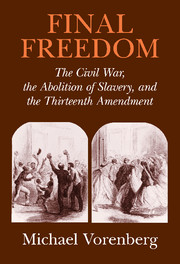Book contents
- Frontmatter
- Contents
- List of Illustrations
- Acknowledgments
- List of Abbreviations
- Introduction
- 1 Slavery's Constitution
- 2 Freedom's Constitution
- 3 Facing Freedom
- 4 Debating Freedom
- 5 The Key Note of Freedom
- 6 The War within a War: Emancipation and the Election of 1864
- 7 A King's Cure
- 8 The Contested Legacy of Constitutional Freedom
- Appendix: Votes on Antislavery Amendment
- Bibliography
- Index
1 - Slavery's Constitution
Published online by Cambridge University Press: 01 September 2009
- Frontmatter
- Contents
- List of Illustrations
- Acknowledgments
- List of Abbreviations
- Introduction
- 1 Slavery's Constitution
- 2 Freedom's Constitution
- 3 Facing Freedom
- 4 Debating Freedom
- 5 The Key Note of Freedom
- 6 The War within a War: Emancipation and the Election of 1864
- 7 A King's Cure
- 8 The Contested Legacy of Constitutional Freedom
- Appendix: Votes on Antislavery Amendment
- Bibliography
- Index
Summary
On July 4, 1854, the abolitionist William Lloyd Garrison observed Independence Day by burning a copy of the United States Constitution. He was disgusted that the Constitution not only permitted the continued enslavement of 4 million African Americans but also required federal officials to return fugitive slaves to their masters. The gesture earned Garrison both praise and scorn, as did his declaration that the founding document was a “covenant with death” and “an agreement with hell.” Today, in an era when burners of the American flag are routinely hauled before the courts, Garrison's destruction of another national icon seems radical in the extreme. The act seems even more poignant when contrasted with today's constitutional politics. When reformers today run into the roadblocks of constitutional provisions, congressional legislation, or judicial decisions, they are much more likely to demand a constitutional amendment than the abandonment of the entire Constitution. Garrison and other abolitionists, however, failed to embrace the amendment alternative.
Ultimately, of corse, opponents of slavery did come to regard a constitutional amendment as the best method of ending slavery, but they did so only after the conflict over slavery had erupted into a shooting war. When Congress finally adopted the antislavery amendment in January 1865, Garrison announced that the Constitution, formerly “a covenant with death,” was now “a covenant with life.” Garrison's praise suggested that the amendment had always been the abolitionists' goal, but, in fact, the measure appeared rather late on the antislavery agenda.
- Type
- Chapter
- Information
- Final FreedomThe Civil War, the Abolition of Slavery, and the Thirteenth Amendment, pp. 8 - 35Publisher: Cambridge University PressPrint publication year: 2001



